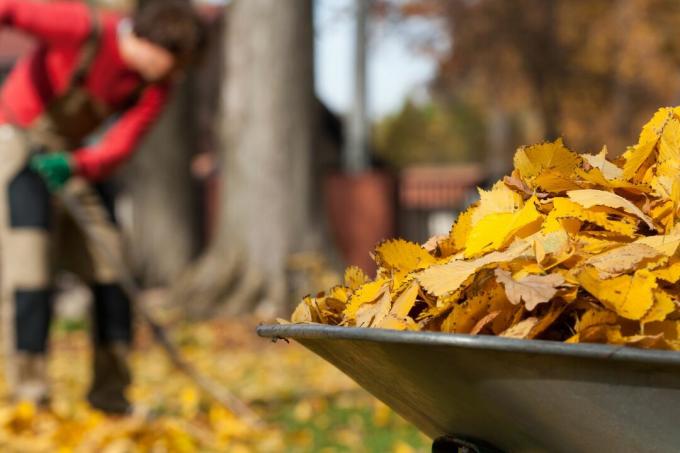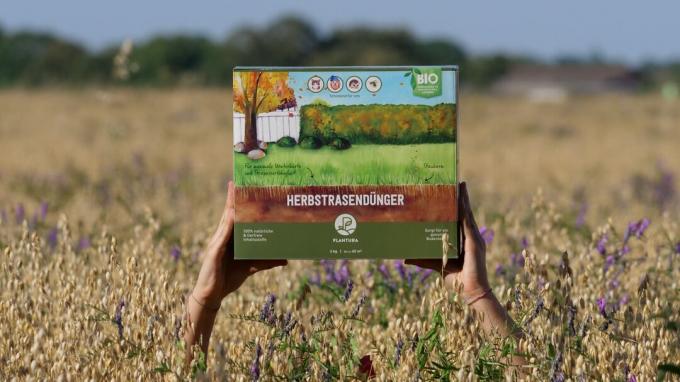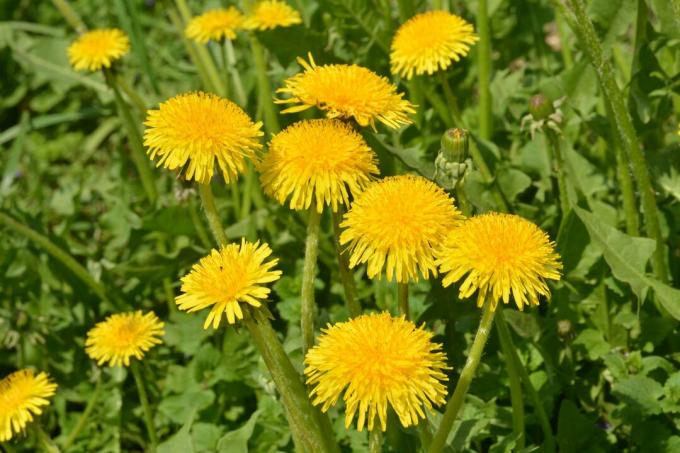Potash fertilizer serves special properties of plants. We'll show you when to use a special potassium fertilizer.

You can find tons of different fertilizers on the market. Potassium fertilizers are obtained, among other things, as a single nutrient fertilizer, but there are also universal fertilizers with an emphasis on potassium that have a higher potassium value compared to other complex fertilizers. We'll tell you when you need to use a potassium fertilizer and what you should be aware of when using potassium fertilizers.
contents
- Potassium fertilizer: properties and composition
- Effect of potash fertilizers on plants
- Recognize potassium deficiency
-
Various potash fertilizers & potassium content
- Patentkali / Potash Magnesia
- Potassium sulfate
- Autumn potassium fertilizer
- Potassium lawn fertilizer
- Thomaskali / phosphorus potash fertilizer
-
Make your own potassium fertilizer
- Comfrey manure
- Dandelion manure
- Fern broth
- Wood ash
Potassium fertilizer: properties and composition
Potassium is a very soft alkali metal and, along with nitrogen and phosphorus, one of the most important plant nutrients. The leaching and mobility of potassium are rather low in the soil. Only about 1 to 2% of the total potassium that is present in the soil is found in the soil solution - and only this 1 to 2% of potassium is directly available to the plants.
Potassium is a natural component of any soil. In Germany its share in the soil is 0.3% to 3%. If you are doing a soil analysis, the ideal potassium level should be between 13 and 25 mg for heavy soils and between 8 and 10 mg of potassium per 100 g of garden soil for light soils. Potassium is present in the soil in the form of positively charged ions and is for the most part attached to the clay minerals and to the humus bound. These bonds are relatively loose and the ions can easily be released again so that they are available to the plants. If the potassium is built into the crystal lattice of the silicates, it can no longer be absorbed by the plants and is therefore bound.

Plants prefer potassium in their uptake, however other nutrients can inhibit the plant's uptake of potassium. These include calcium, magnesium, ammonium and also sodium. In addition, low pH levels can also inhibit the absorption of potassium. If the pH value falls below 4, the plant roots even release the potassium again. It is also easy to move in the plant and is transported to where it is needed. Since potassium is important for cell structure, young leaves are always richer in potassium than older ones.
Effect of potash fertilizers on plants
The plants need potassium for various processes such as:
- Control of metabolic processes
- Regulation of the water balance
- Regulation of the function of the stomata
- Increasing the resistance of plants to infections
- Increasing the frost hardiness of the plants (a high potassium content in the vacuoles lowers the freezing point of the cell sap)
The plants store the potassium in the vacuoles and help regulate the turgor. The turgor, also called turgor pressure, describes the pressure that the cell sap exerts on the cell walls. In certain compartments of plant cells, an osmotic potential is built up with the help of the enrichment of potassium. This should be higher than in the vicinity of the cells. This allows water to flow into the cells, a turgor is built up and the plant cells are filled with water and tightened. However, if, for example, the substrate is too salty, the exact opposite reaction can occur. Then water flows out of the cells and the plants go limp.
Can too much potassium harm the plants?
An oversupply of potassium can also cause damage to your plants and trigger various symptoms. These include growth inhibitions, root burns, damage to the leaves or necrosis on them. Unfortunately, these symptoms are similar to those of an undersupply. As a rule, however, there is hardly any direct excess of potassium. If such damage occurs, it is generally salt damage, as plants can absorb relatively high amounts of potassium without major problems.
Recognize potassium deficiency
Plants show very different symptoms when there is a deficiency in the nutrient potassium. These symptoms include, for example, the yellowish discoloration of the leaf edges, which is also known as chlorosis. The leaf margins can even turn brown and die off, i.e. become necrotic.

These necroses always develop on the older leaves first and are only recognizable as small black dots at the beginning. When there is a severe lack of potassium, the plant shifts its potassium from the older leaves to the younger ones. Because of this, symptoms always appear on the older leaves first. Another symptom can be that the leaves curl and curl up. In addition, the plants wilt and the leaves only hang limply on the plants. This is also called withered. Stunted growth and an increased susceptibility to disease are also associated with a potassium deficiency. This can also affect the stability of the plants and the tolerance to frost and drought.
Summary: Recognize potassium deficiency in plants
- Leaf margins turn yellowish
- Necrosis on the older leaves
- Leaves curl up and twist
- Plants wither
- Stunted growth
- Higher susceptibility to disease
- Lower stability
Various potash fertilizers & potassium content
Basically, only water-soluble potassium salts are used as potassium fertilizers. It is also important to know that calcium and potassium act as antagonists in the soil. Therefore, you have to apply these two nutrients in the right ratio.

A special potassium fertilization is of course necessary in the case of an acute deficiency. You can find out whether there is a deficiency by means of a soil analysis or recognize deficiency symptoms. But especially in autumn you should rely on potassium-based fertilization to make lawns and bushes winter hardy. In the following we present the different types of potassium fertilizers:
Patentkali / Potash Magnesia
Patentkali fertilizer is a special fertilizer that contains potassium (K2SO4), Magnesium (MgSO4) and also contains sulfur. The fertilizer consists of 30% potassium oxide, 10% magnesium oxide, 15% sulfur and is actually called potassium magnesia, although the trade name is Patentkali. These fertilizers are water-soluble and the nutrients for our plants are quickly available. It is also obtained from the naturally occurring mineral kieserite. Since Patentkali is chloride-free, it can also be used for sensitive plants and shrubs such as rhododendron (rhododendron) or Boxwood (Buxus) be used. Patentkali is available in fine to coarse grains and is suitable for both basic and top dressing - unfortunately it is not suitable for liquid fertilization.
Potassium sulfate
Potassium sulphate is the potassium salt of sulfuric acid (K2SO4) and is used as a fertilizer for chloride-sensitive plants such as Raspberries (Rubus idaeus) or Blackberries (Rubus sectio Rubus). Potassium sulphate contains 50% potassium and 45% sulfur and is a low-salt fertilizer. It is also used in homeopathy, as an extinguishing powder and in many areas of industry and technology. This fertilizer is a white salt that is fine to coarse and is also suitable for liquid fertilization.
Autumn potassium fertilizer
Most autumn fertilizers contain potassium, because a sufficient supply of potassium promotes the frost hardiness of plants. Since potassium is particularly important for winter or frost hardiness, you should not do without it in autumn fertilization. This effect can be compared with an antifreeze, because the potassium is stored in the plant cells and thus lowers the freezing point of the cell sap. Thus the cell remains functional. When freezing, the cell sap would expand, similar to water, and destroy the cell, but this does not happen due to the potassium.
Potassium lawn fertilizer
If you want a healthy and strong lawn, potassium fertilization is important. Fertilization with potassium is particularly important in autumn, as a sufficient supply of potassium can prevent snow mold infestation. In our Plantura organic autumn lawn fertilizer therefore contains an extra portion of potassium so that your lawn can survive the winter safely. In a lawn fertilizer, the potassium strengthens the resilience of the plants, it protects against drought, cold and disease - here it is important that the Fertilize lawn in spring and also the Fertilizing the lawn in autumn not to forget.

Thomaskali / phosphorus potash fertilizer
A fertilizer, which consists mainly of potassium and phosphorus, is also called Thomaskali. Thomaskali has a granular structure and consists of 8% phosphorus (P.2O5), 15% potassium oxide (K2O) and 6% magnesium oxide (MgO). The fertilizer can also be found under the term “Thomas flour”, it is a by-product of steel or iron production.
Make your own potassium fertilizer
You can also make some high-potassium fertilizers yourself. Different liquid manure and broths, for example, are suitable for this.
Comfrey manure
A manure from comfrey (Symphytum) is made from 1 kg of fresh comfrey leaves, which are chopped up and fermented with about two hands on marigolds in 10 liters of water. This liquid manure can be used to strengthen plants and contains many nutrients. Comfrey manure contains a particularly large amount of nitrogen and potassium. Therefore, the liquid manure is ideal for fertilizing heavily consuming vegetables and as an additive to compost.
Dandelion manure
For optimal dandelion manure, put about 2 kg of fresh dandelion leaves and flowers in 10 liters of water (Taraxacum) at. This liquid manure has a stimulating effect on plant growth and contains a lot of potassium and calcium. You can spray the liquid manure undiluted over plants and over the ground.

Fern broth
For the bracken broth you need about 5 kg of fresh bracken (Pteridium aquilinum). You can also take about 1 kg of dried bracken and add it to 10 liters of water. The ferns are pickled for a day and the broth cooked for about half an hour. The fern broth mobilizes the potassium from the compost and from the soil and can also be used against lice.
However, you can not only use manure and broths for fertilization, but also other products that arise in the household.
Wood ash
You can find wood ash in your fireplace or on the charcoal grill. This is ideal for fertilizing, because the ash contains a lot of potassium, lime, phosphorus and iron. But ash is not suitable for all plants. Those that need acidic soil should not be fertilized with it, as it neutralizes the soil. These plants include Orchids (Orchidaceae), rhododendrons, Peonies (Paeonia), Daffodils (Narcissus) and many more. However, certain plants are particularly happy about a portion of ash. These include tomatoes (Solanum lycopersicum), Gooseberries (Ribes uva-crispa), potatoes (Solanum tuberosum) and Roses (pink).
NPK fertilizer In addition to potassium, they also contain nitrogen and phosphorus. In our special article you will find out everything about the advantages of NPK fertilizers.
